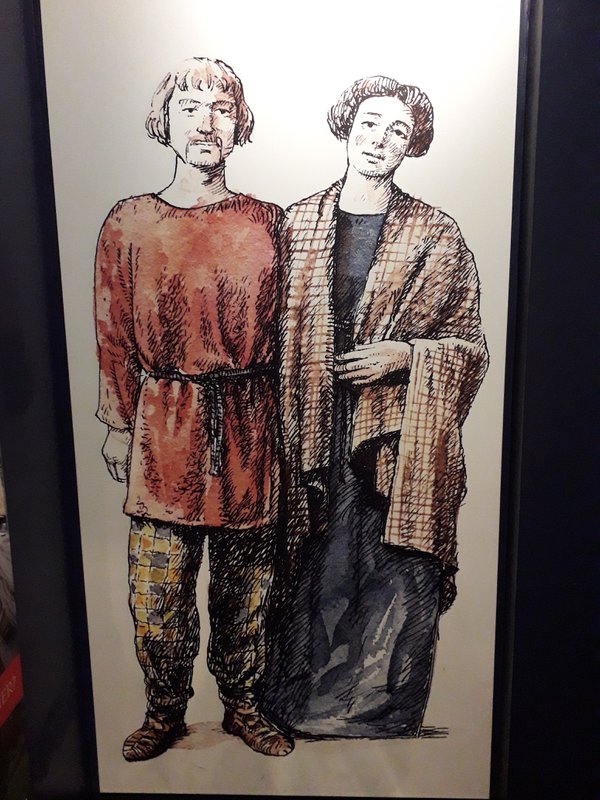Britons - Life before the Fort at Wallsend
These teacher notes tell you about the life of the people who came before the Romans. You can download a copy of these teacher notes below.
Download: Britons-Life before the Fort at Wallsend PDF resource here (4.1 MB)

Britons
Before the Romans built Segedunum fort, this area was farm land, lying within the territories of the Brigantes tribe. Archaeologists have found evidence of ploughing and the hand digging of furrows in preparation for the sowing of crops. The farmstead, which would have been made up of round houses, was probably to the north of the later fort.
Brigantes
The Brigantes were a large tribe whose lands stretched from Yorkshire up to Northumberland. It is likely that the tribe was actually made up of smaller tribes with different cultural identities. The farmstead at Wallsend may have belonged to a tribal area that covered the coastal area between the River Tyne and the River Aln.
Before the Romans
Before the Romans arrived here, the Britons lived in farmsteads about a 15 minute (1km) walk apart. Some were made up of one or two main, larger roundhouses and a number of smaller roundhouses marked out by impressive earth banks and ditches. Fields for crops and pasture for animals would lie beyond the houses.
A farmstead like this could be home for between 15 and 30 people and could take up as much space as an entire Roman fort.
Round houses
The local people would have built circular houses with timber posts, wattle and daub walls and thatched roofs. In some large roundhouses, cattle and other animals may have been kept on the ground floor, while the people lived on a timber floor above them.
Food
Evidence recovered from archaeological excavations can tell us a bit about what they ate. It shows that people grew spelt wheat and barley and raised cattle, sheep and occasionally pigs. Chickens were extremely rare. They grew vegetables such as cabbages, peas and beans and fruits such as apples, pears and sloes. They no doubt ate many other things which have not yet been found in excavations.
Some animals may have been hunted for food, such as hare, deer and wild boar, although hunting was probably more for entertainment than a regular way of providing meals. Britain was known in Roman times for its hunting dogs and they were exported from here to other parts of the Roman Empire.
Salt was imported from the coast and used to preserve food and add flavour to meals. It was important to preserve food to last through the winter months, keeping it safe from damp and pests. Food could be dried, smoked, salted or preserved in honey or fat. The food they ate changed over the course of the year; summer was the time for fresh vegetables and autumn the time for fresh fruit, but by spring much of what they ate had been in storage for months.
Water had to be collected from nearby streams or springs as the River Tyne is tidal and would taste of sea-water. Beer was also drunk, perhaps sometimes flavoured with honey and herbs.
Natural Resources
The people living here would have relied on natural resources. Heather and bracken were used for bedding, thatch, fuel or animal fodder. Plants could also be used to produce dyes to colour wool. Woodland would have been managed to provide a range of different woods needed for construction and fuel. The arrival of the Roman army would have had a huge impact on natural resources.
Life under the Romans
Evidence suggests that the land beneath the fort at Wallsend had been prepared for crops just before the fort was built, suggesting that the local people were not expecting a fort to be built there. The Romans confiscated the land and farmers had to move elsewhere. It must have been a great upheaval.
The building of the Wall badly disrupted the way of life for the local people and in the twenty years or so following its building, many farmsteads on the coastal plain were abandoned. We do not know the exact reason why. Afterwards, the local people seem to start raising cattle in a large way instead.
Archaeologists continue to investigate
these questions:
Did the Romans have a cleared zone north of the wall where people could not settle?
Did they move the people of the coastal plain south of the wall?
Did the Wall cut across social and economic networks leaving the farmsteads isolated and unable to function?
What do you think? If you were a Briton living in this area when the Romans decided to build Hadrian’s Wall, how would you feel?




